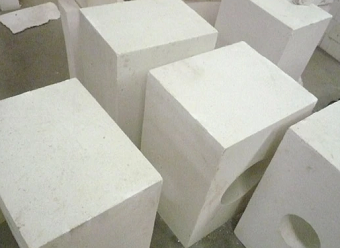Characteristic of zirconia carbon brick
Apr 26, 2022
Zirconia carbon brick refers to refractory products made of stabilized zirconia and flake graphite as raw materials. Zirconium-carbon brick is a carbon-bonded product that firmly combines the stabilized zirconia and flake graphite in the green body with the carbon network structure formed by the carbonization of organic binder phenolic resin or pitch. It is the best refractory product for the protection of continuous caster mold protection and tundish slag erosion.
Characteristic of zirconia carbon brick
The slag corrosion resistance of zirconium carbon bricks increases with the increase of ZrO2 content, but the thermal shock stability decreases accordingly. The optimal ZrO2 content is 60%-80%, and the C+SiC content is 18%-28%. Zirconium carbon bricks have excellent resistance to slag erosion, especially the mold slag resistant to continuous casting calcium, and its erosion rate is 30% to 40% of that of aluminum carbon materials. The zirconium carbon brick containing ZrO275% and C+SiC 21% has an apparent porosity of 15.5%, a bulk density of 3.65g/cm3, a flexural strength of 8.3MPa, and a thermal expansion rate of 0.46% at 1000°C.

The manufacturing process is based on zirconia containing ZrO2≥98%, adding stabilizer, mixing, briquetting, and calcining stabilized zirconia and flake graphite containing more than 95% fixed carbon as raw materials, using phenolic resin or pitch. as a binding agent.
In the production of zirconium carbon bricks, the batching error should be ±0.5%, the mixing should use a high-speed mixer, the material temperature should be strictly controlled, and the specified mixing time must be guaranteed; it should be formed by a cold isostatic press, and the forming pressure should be 150MPa; the green body should be dried. The temperature difference in the kiln is ±2°C; in tunnel kiln burial or reduction firing, the temperature difference between the upper and lower kilns should be as small as possible, and the firing temperature is 1350°C.
This product is used as a composite slag line sleeve for the aluminum-carbon long nozzle and aluminum-carbon immersed nozzle slag line. To enhance its slag resistance, the mold slag erosion rate of the carbon material is lower than that of the aluminum carbon material, and the error carbon material is 2mm/h. , the aluminum carbon material is 5mm/h
Relevant information
-

Main properties of magnesium oxide refractory
Performance characteristics of magnesia refractories and other basic refractories Performance characteristics of magnesia refractories and other basic refractories Refractories containing more than 80% ... -

What properties of lightweight insulation fire clay bricks can be improved by the addition of kyanite?
Lightweight insulation fire clay bricks are a kind of shaped refractory material with clay as the main raw material, which is processed, shaped, dried, and calcined with clay. on the kiln. Due to the r ... -

How is the effect of white fused alumina abrasive used in refractory materials?
After mixing, forming, drying, and firing at high temperature in a shuttle kiln. The product has the characteristics of high refractoriness, good thermal shock stability of white corundum, high high te ... -

Characteristics of refractory magnesia chrome bricks for lime kiln
Lime kilns are mainly classified into square kilns and circular kilns. According to the classification of fired products, they can be divided into lime kilns, ceramic kilns, cement kilns, glass kilns, ...

